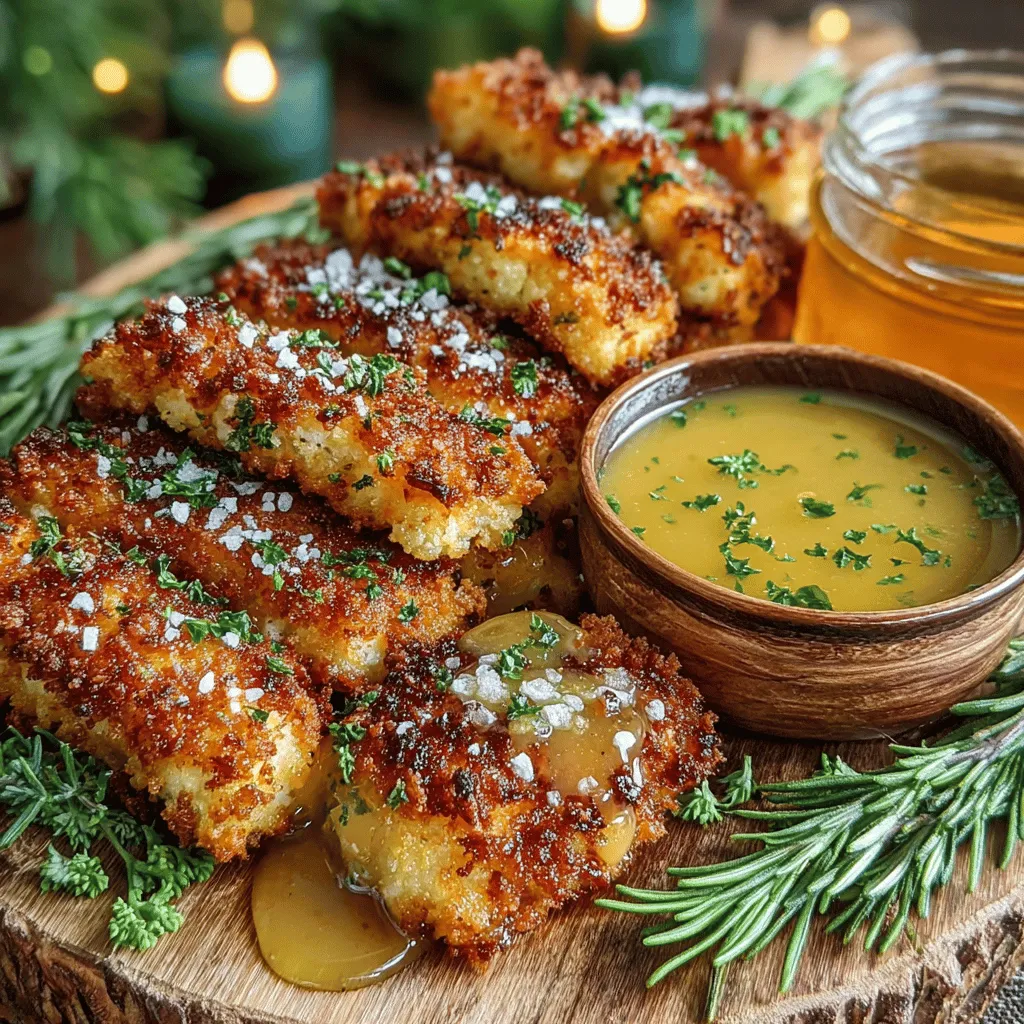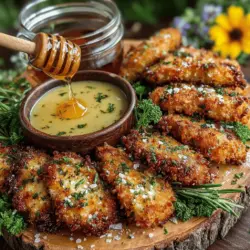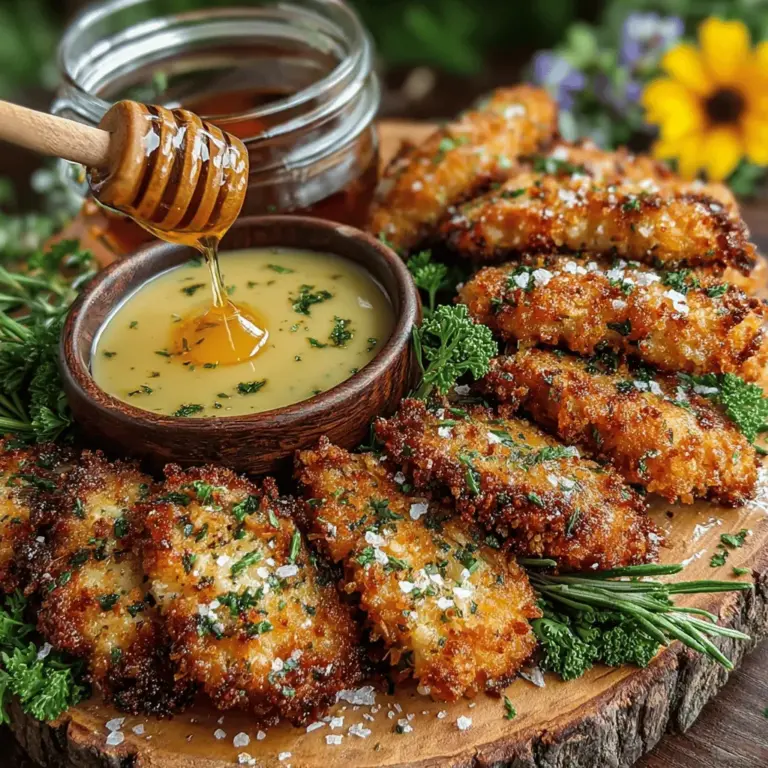Introduction
Crunchy chicken tenders are a quintessential comfort food that appeals to people of all ages. Their satisfying crunch and tender inside make them a popular choice for a snack, a hearty main dish, or a crowd-pleasing appetizer at gatherings. The versatility of chicken tenders is unmatched; they can be paired with various dips, but none is as delightful as the sweet and tangy honey mustard dip. This combination not only enhances the flavors of the tenders but also elevates the overall dining experience, making it a must-try recipe in any home kitchen.
Ingredients
– 1 pound chicken tenders
– 1 cup buttermilk
– 1 teaspoon garlic powder
– 1 teaspoon onion powder
– 1 teaspoon smoked paprika
– 1 teaspoon dried Italian herbs
– 1 cup all-purpose flour
– 1 cup panko breadcrumbs
– Salt and pepper to taste
– Oil for frying
For the Honey Mustard Dip:
– 1/2 cup mayonnaise
– 1/4 cup Dijon mustard
– 1/4 cup honey
– 1 tablespoon apple cider vinegar
Instructions
1. In a large bowl, combine the buttermilk, garlic powder, onion powder, smoked paprika, dried Italian herbs, salt, and pepper. Whisk until well blended.
2. Add the chicken tenders to the marinade, ensuring they are fully coated. Cover and refrigerate for at least 1 hour, or up to overnight for optimal flavor.
3. In a separate shallow dish, place the all-purpose flour and season with salt and pepper. Mix well.
4. In another shallow dish, add the panko breadcrumbs.
5. Remove the chicken tenders from the marinade, allowing excess buttermilk to drip off. Dredge each tender in the seasoned flour, shaking off the excess, then dip back into the buttermilk before coating with panko breadcrumbs.
6. Heat oil in a deep skillet or fryer to 350°F (175°C).
7. Fry the coated chicken tenders in batches, ensuring not to overcrowd the pan. Cook for about 4-6 minutes on each side or until golden brown and fully cooked.
8. Remove the chicken tenders from the oil and place them on a paper towel-lined plate to absorb excess oil.
Understanding the Ingredients
Chicken Tenders
Chicken tenders are the small strips of meat that come from the breast of the chicken. They are known for their tenderness and ability to absorb flavors, making them an ideal choice for this recipe. Their relatively quick cooking time also makes them perfect for weeknight dinners or impromptu gatherings.
Buttermilk
Buttermilk plays a crucial role in marinating chicken. It not only tenderizes the meat but also infuses it with moisture and flavor. The acidity in buttermilk helps break down proteins, leading to a juicy and flavorful tender.
Spices and Seasonings
The combination of garlic powder, onion powder, smoked paprika, and dried Italian herbs adds depth to the flavor profile of the chicken tenders. Each seasoning contributes its unique taste, enhancing the overall dish and making it more aromatic.
Coating
The coating for chicken tenders is essential for achieving that desired crunch. All-purpose flour acts as a base layer, while panko breadcrumbs provide the extra crunchiness. Panko, with its larger flakes, creates a light and crispy texture that elevates the eating experience.
Honey Mustard Dip
The honey mustard dip is the perfect complement to the crunchy chicken tenders. Made with mayonnaise, Dijon mustard, honey, and apple cider vinegar, it strikes a balance between sweet and tangy. This dip not only enhances the flavor of the chicken but also offers a creamy texture that contrasts beautifully with the crunchiness of the tenders.
The Marination Process
Marinating the chicken in buttermilk is a key step in this recipe.
Flavor Infusion
The spices mixed into the buttermilk not only enhance the flavor of the chicken but also ensure that every bite is bursting with taste. The longer the chicken marinates, the more pronounced the flavor will be.
Texture Improvement
Marination significantly contributes to the juiciness and tenderness of the chicken. By allowing the chicken to soak in the buttermilk, the meat becomes more succulent, making for an irresistible bite.
Recommended Marination Time
For the best results, it’s recommended to marinate the chicken for at least 1 hour. However, marinating overnight will yield even more flavorful and tender chicken tenders.
Preparing the Coatings
Setting up the coatings is a straightforward process that ensures your chicken tenders achieve the perfect crunch.
Flour Preparation
Seasoning the flour is vital for adding flavor to the chicken. A simple mix of salt and pepper is often sufficient, but feel free to get creative with additional spices if desired.
Breadcrumb Mixture
Using panko breadcrumbs is essential for achieving that signature crunch. You can enhance the flavor of the breadcrumbs by mixing in some dried Italian herbs, which will provide a lovely aroma and additional taste to the coating. This extra step will ensure that each bite is not only crunchy but also packed with flavor.

Techniques for Coating
Frying Techniques for Perfect Chicken Tenders
To achieve the ultimate crunchy chicken tenders, mastering the frying process is essential. Here’s a detailed guide to help you fry to perfection.
Oil Temperature
The right oil temperature is crucial for achieving a perfectly crispy exterior. Aim for a temperature between 350°F to 375°F (175°C to 190°C). Use a deep-fry thermometer to monitor the temperature accurately. If you don’t have one, you can test the oil by dropping in a small piece of bread; if it sizzles and turns golden brown within 60 seconds, the oil is ready.
Batch Cooking
Avoid overcrowding the pan when frying chicken tenders. Cooking too many at once lowers the oil temperature, resulting in soggy tenders. Instead, fry in small batches, allowing enough space for each piece to cook evenly. This ensures that each tender receives the right amount of heat and maintains its crispiness.
Cooking Time
Fry the chicken tenders for approximately 4 to 5 minutes on each side, or until they achieve a golden-brown crust. The exact cooking time may vary based on the thickness of your tenders, so keep an eye on them to avoid overcooking. Using a meat thermometer can help; the internal temperature should reach 165°F (75°C).
Draining Excess Oil
Once cooked, it’s essential to drain the excess oil to maintain that crunchy texture. Transfer the tenders to a plate lined with paper towels immediately after frying. This step absorbs any remaining oil, ensuring your chicken remains crispy.
Crafting the Honey Mustard Dip
A delightful honey mustard dip enhances the flavor of your chicken tenders. Here’s how to make it perfectly.
Ingredient Ratios
For a well-balanced honey mustard dip, use a ratio of 2:1 for honey to mustard. Combine 2 tablespoons of honey with 1 tablespoon of Dijon mustard for a sweet yet tangy flavor. Adjust the quantities according to your taste preferences.
Whisking Technique
To achieve a smooth and creamy consistency, whisk the ingredients together vigorously in a bowl. A whisk enhances the emulsification of the dip, helping to blend the honey and mustard seamlessly. If you prefer a thinner dip, add a splash of water or apple cider vinegar until you reach the desired consistency.
Personalization
Feel free to personalize your honey mustard dip. Add a pinch of garlic powder for an extra kick or a dash of cayenne pepper for some heat. Experimenting with different mustards—such as whole grain or spicy brown—can also create a unique flavor profile that suits your palate.
Serving Suggestions
Once your crunchy chicken tenders and honey mustard dip are ready, it’s time to serve them up creatively.
Presentation
Arrange the chicken tenders neatly on a serving platter. You can garnish with fresh herbs like parsley or cilantro for a pop of color. Serve the honey mustard dip in a small bowl placed in the center, making it easy for guests to access.
Pairing Options
Complement your chicken tenders with sides that enhance the meal. Fresh vegetable sticks, such as carrots and celery, or crispy French fries make excellent accompaniments. For a healthier option, consider a side salad with a light vinaigrette.
Occasion Ideas
These crunchy chicken tenders are versatile and perfect for various occasions. Serve them at family dinners, game days, or parties. They can also be a hit at summer barbecues or casual get-togethers, making them a go-to comfort food for any gathering.
Conclusion
Making crunchy chicken tenders paired with a sweet and tangy honey mustard dip is not just a cooking experience; it’s a delightful culinary adventure. With straightforward techniques and simple ingredients, this dish is sure to become a family favorite and a crowd-pleaser. Whether you’re hosting a gathering or enjoying a cozy night in, this recipe promises satisfying flavors that everyone will love. Try making these tenders at home and indulge in the comforting, homemade goodness that can easily outshine store-bought versions. Enjoy the process, and savor the results!


